
 USN Destroyer Leaders:
USN Destroyer Leaders:
USS Mitscher, John Mc Cain, Willis A. Lee, Wilkinson
Cold War US DDs:
Fletcher DDE class | Gearing DDE class | Gearing FRAM I class | Sumner FRAM II class | Forrest Sherman class | Mitscher class | Farragut class | Norfolk class | Charles F. Adams class | Spruance class | Arleigh Burke classThe Mitscher class were four experimental large conventional destroyers, considerably larger than all previous one albeit more reasonable than the previous massive USS Norfolk (DL-1), earliest attempt of “fleet escort, destroyer”, cruiser-size. Due to their reclassifications as destroyers leaders (DL-2 to 5)they were not the first post-war destroyer class when commissioned in 1953-1954. They stayed in service until 1969 and the early 1970s but Mischer and Wilkinson were converted as guided missile destroyers (DDG) for more service years until 1980, in service with the Pacific and Mediterranean 7th and 6th fleets, John Mc Cain making a tour of duty in Vietnam.
Genesis of the Design
The cold war years meant many new developments and ideas emerging from wartime years (missile, radio-guidance, radar assisted gunnery, new ASW weapons, helicopters) called for a redefinition of the role of cruisers and destroyers around the new ocean prince: The Fleet Aircraft Carrier. Designed under project SCB 5, ordered 3 August 1948 and later named after rece,tky passed out WW2 admirals, these vessels displaced 3,331 tons (light) and up to 4,855 tons fully loaded for 494 feet or 151 m which was cruiser-size. Unlike the last destroyer class, the Allen M. Sumner, armed with the same standard and ubiquitous twin 5-in/38 turrets they were to be armed with brand new weapons in development, but not missiles, still in their infancy. In 1948, their main role as defined was to escort the new, very large and precious USS United States, planned and just laid down a year prior, and after its cancellation, the new supercarriers of the Forrestal class.
Fierce debates in the admiralty questioned the validity of the destroyer as a fleet escort, between proponent of a unique, very large and versatile “fleet escort” which was a blend of cruiser and destroyer, practically making both classes obsolete, and those who wanted a clearer separation between cruisers, ussable with their heavy artillery for amphibious assaults, and smaller destroyers in numbers large enough to detach some in “hunter-killer” groups. Eventually the latter task was given to the new frigates developed, and destroyers returned to the escort mission.
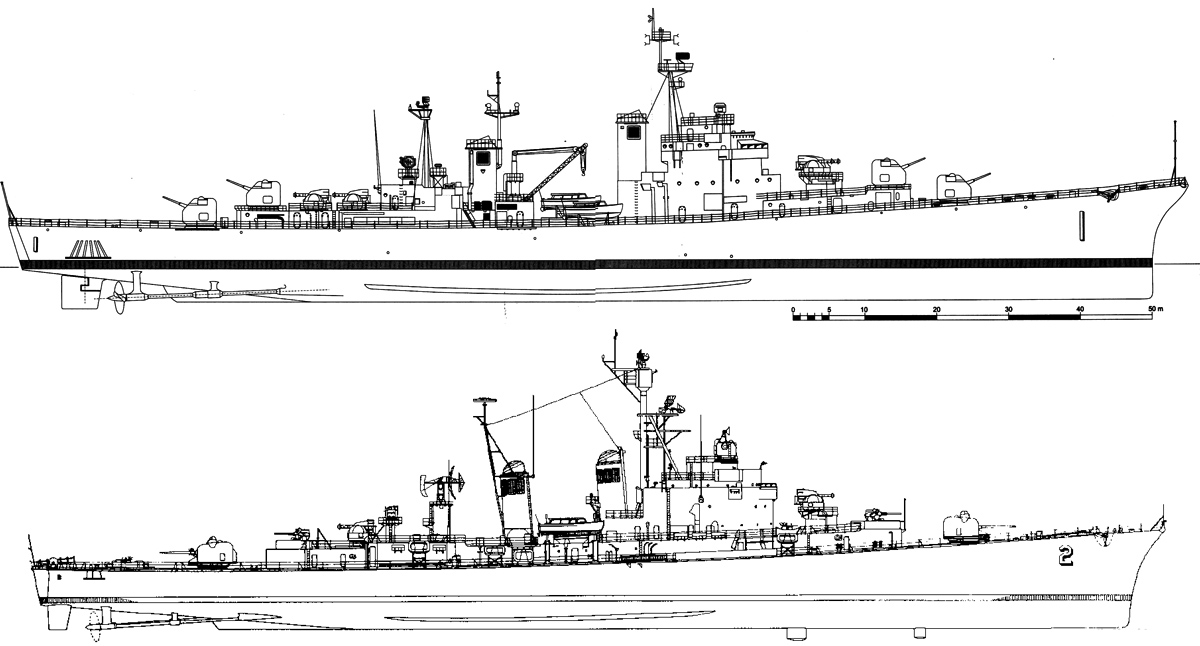
Comparison between USS Norfolk (DL1) and the next four destroyer leaders of the Mitscher class
The SB5 project leaned like Norfolk towards the first option of universal “fleet escort” still, but on a more reasonable scale to be more acceptable in a postwar budget cuts context. Beyond these questions, each ship was to be given a different propulsion arrangement, and tests different weapons and sensors to make comparison and determine the best solutions for future destroyer design.
The Mitscher class ended as winner of internal Navy debates started in 1945 seeing the much larger CL-154 class anti aircraft cruisers canceled and the termination of the Norfolk based both on cost effectiveness grounds.
Eventually, the Mitscher would appear also a bit too large as destroyers, and were reclassed as “DL” for “Destroyer, Leader”, and “Fleet Escort (Destroyer)”. Their example led to the creation of the even larger Farragut serie of similar vessels, but reclassified DLGs since they were missile-armed and as cruisers for the next Leahy class, a better fir for their size, especially compared to the “regular” destroyers (DD) incarnated by the Forrest Sherman class (the first was laid down in 1953).
Design of the class
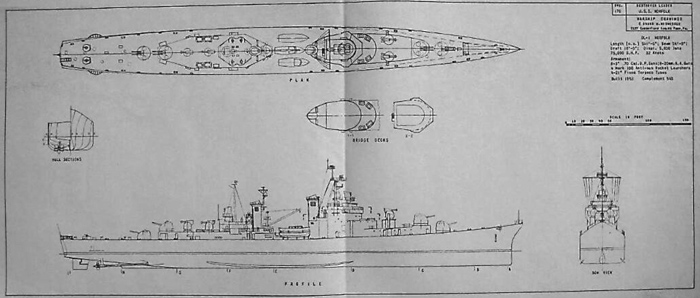
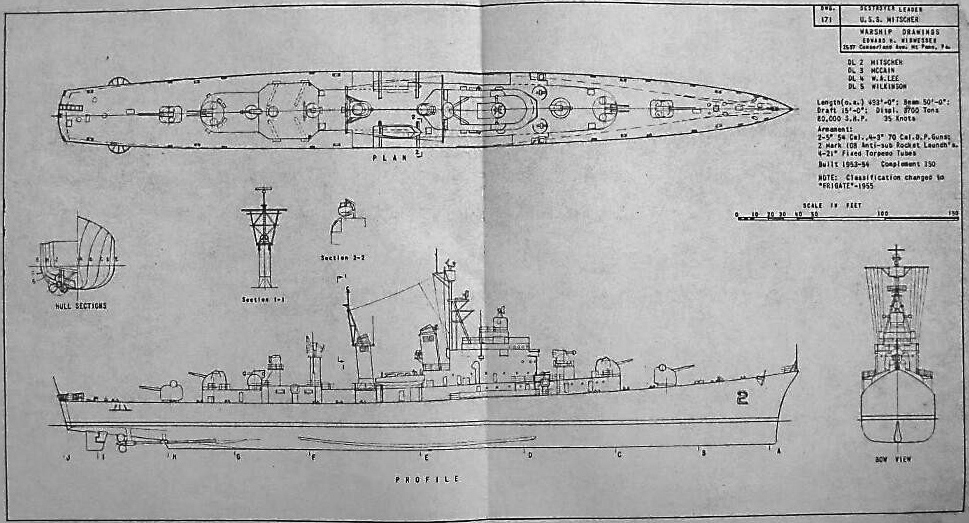
Ship plans (large ones are sold by wothrpoint.com among others, apparently they are not open source yet.
Hull and general design
The Mitscher class as the previous USS Norfolk used flush-deck hulls of very large size. They displaced 3,642 tons standard and 4,855 full load, which was unprecedented for a destroyer, although they were quickly reclassified as Destroyers Leaders. They measured 490 ft (150 m) by 47.5 ft (14.5 m) in beam and a 14.7 ft (4.5 m) draft at full load. They were more reasonable than USS Norfolk which reached almost 6,000 tonnes at full load and was 540 feets long, an attempt to create a budget acceptable proposition for a class.
Construction was not revolutionary however as they repeated the same techniques used for Norfolk and previous Gearing-Sumner class destroyers.
The main hull was extensively compartimented, superstructure being made in aluminium to preserve stability, with internal, extensive steel bracing to support the massive arrays.
Armour protection layout & safety

A 3D schematic of the Mitscher class (war thunder)
Just like all previous destroyers, it was kept minimal. The Central Operation inherited from WW2 cruisers was deep inside the hull and protected by 0.5 in STS panels. There was a stray of the same thickness over the steering compartment aft and over the ammunition magazines, also deep in the hull. No belt, no armored deck, superstructure in light steel and aluminium (with internal framing reinforcement to support the arrays). The ASW protection was ensured by a dozen compartments separated by bulkheads, plus a double hull on 90% of the lenght. Fire protection was limited to the traditional water pump and fire brigade with hoses. N?o sprinkler system at the time for that category of ships. Aircraft carriers were far more secured on that point.
The crew could evacuate on rubber boats boats mostly, distributed along the superstructure with rapid emergency dump. Two motor cutters for liaison were installed on davits amidships, between funnels on either side.
Powerplant
The Mitscher class were powered all by two shaft geared steam turbines fed by four boilers for a total as designed of 80,000 shp (60,000 kW) and a top speed as required of 30 knots (56 km/h; 35 mph). Range was to be 4,500 nmi (8,300 km; 5,200 mi) at 20 knots (37 km/h; 23 mph), just enough for Pacific Operations. To compare, the previous DL-1 USS Norfolk had also 80,000 hp but this was procured by 60 MW diesel generators steam turbines plus 500 kW thanks to two 250 kW generators (later 300 KW and eventually 3 MW with 4×750 kW generators). This was a return to tested and trusted solutions, yet the USN crucially wanted to test different configurations to determine the best approach for a later, larger production. This was later criticized as shortening their active life by a decade.
USS Mitscher: Four 1,200 psi Foster Wheeler boilers, two GE steam propulsion turbines for 60,000 combined shaft horsepower (44.742 MW) and 34 knots (63 km/h; 39 mph).
USS John Mc Cain: Same, but over 30 knots (56 km/h; 35 mph)
USS Willis A. Lee: Same. Alterations done after FRAM refit.
USS Wilkison: Same, 4 Foster Wheeler boilers, alterations done after DDG refit.
In the early 1960s, the Mitscher class underwent modernization through a Class Improvement Program (CIP), which included the replacement of the boilers on the first two ships of the class.
Armament
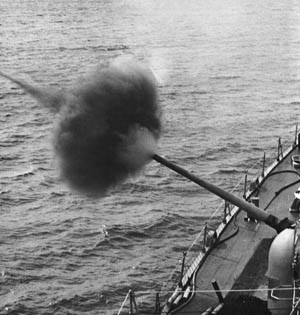 It was quite different from USS Norfolk, as on the later only twin 3-in (76 mm) guns were used for a dual purpose role, but evidently new, larger calibers were more reassuring to the Navy. However in 1948 the intended new duel purpose 5-in/54 models were not yeat available, still in development. Thus, the Mitscher were planned with these. They received just two turrets, completed by four twin 3-in DP, still a few single Oerlikons, survivance from WW2 and quickly removed, plus a comprehensive ASW suite.
It was quite different from USS Norfolk, as on the later only twin 3-in (76 mm) guns were used for a dual purpose role, but evidently new, larger calibers were more reassuring to the Navy. However in 1948 the intended new duel purpose 5-in/54 models were not yeat available, still in development. Thus, the Mitscher were planned with these. They received just two turrets, completed by four twin 3-in DP, still a few single Oerlikons, survivance from WW2 and quickly removed, plus a comprehensive ASW suite.
2×5 in (127 mm)/54 Mark 42 guns
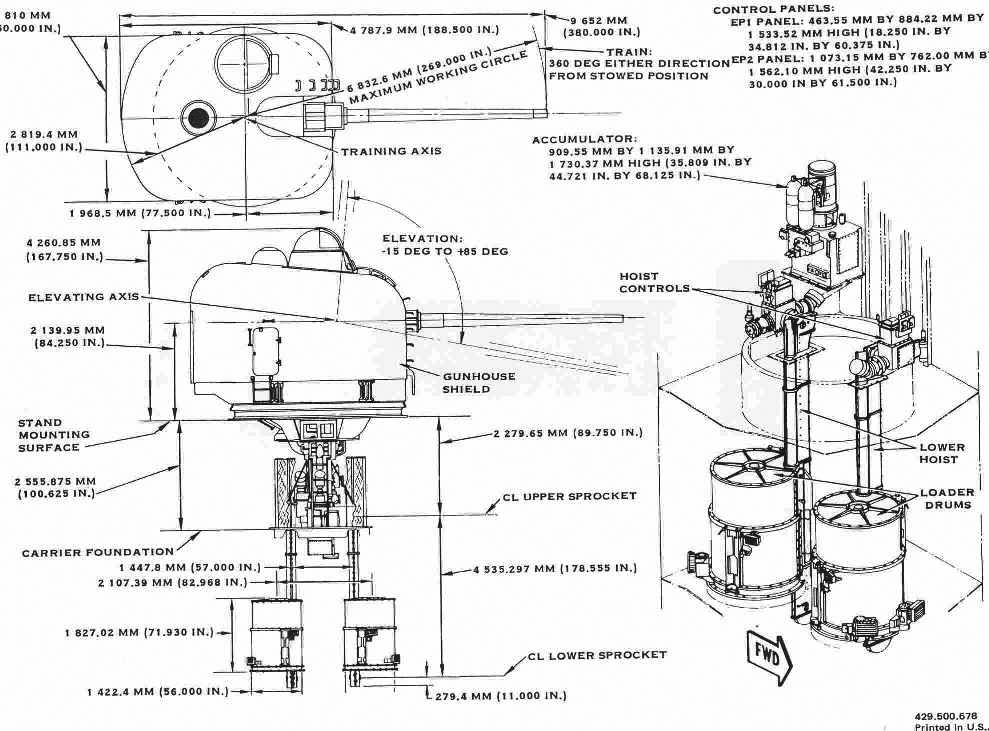
In short, this standard turret fired a 127 x 835mm .R Conventional 31.75 kg shell at up to +85° elevation, at 40 rpm to 2,650 ft/s and 25,909 yd (23,691.2 m/+45°) against ships or a 51,600 ft (15,727.7 m) ceiling. Read more
2×2 3 in/70 (76 mm) Mark 37 guns

Same as on the USS Norfolk, these were however not encased in a turret. These rather good guns, but with mediocre mount, unreliable and hard to maintain. So much so they were retired as soon as allowed, having the shortest service span of any USN weapon, with perhaps the infamous 1930 “chicago piano”. In fact only DL-1 (USS Norfolk) retained these for all her career. On the Mitscher, each barrel was supplied by 1,000 rounds. The Mark 37 Mod 0 mounts, protected by weather proof fiberglass gun shields were located fore and aft of the superstructure, superfiring over the 5-in/54 main guns. They were removed at the first occasion during refits. More on these.
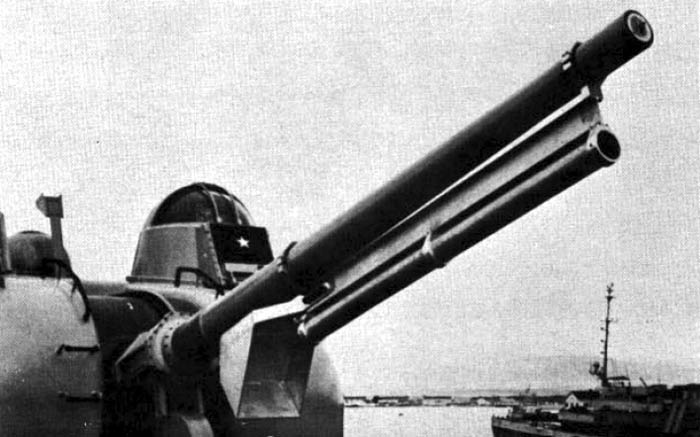
Experimental Loki rocket tube on USSJohn S.McCain’s 3-in mount, c1962
8 x 20 mm guns
Seems surprising that the good old 20mm/70 Oerlikon was still part of a destroyer defence. The reasons are obscure, since this weapon was already removed in and replaced by the 40 mm Bofors alone in 1945, but yet it survived on many ships, from auxiliaries to OPVs until recent years and is still used by many navies around the globe. These four twin 20 mm AA guns were placed abaft the main bridge forward, on either side, and aft, but plansh don’t shows these, but likely theywere abaft the second funnel. As shown in a model, it seems only the forward pair survived, and was removed entirely during the 1960s refits.
4 x 21 inch (533 mm) torpedo tubes

Before the introduction of the standard Mark 24 triple banks for Mk.48 acoustic torpedoes, USN ships still had earlier models of torpedoes for both antiship and ASW roles. It was likely the standard (since 1948) 21″ (53.3 cm) Mark 35:
Design started 1946 as a universal model designed to replace all ordnance in service, namely the Marks 24, 32 and 33, with 400 produced between 1949 and 1952 and service until 1960, replaced by the Mark 37. Final settings came from the fire control system via a 1″ (25 mm) diameter umbilical cable cut away during its rube throwing. This was primarily an ASW weapon, and secondary anti-surface weapon. Settings included pre-enable run-out course/distance, search ceiling and floor, right/left circling search pattern, taking all what was explored in WW2. src
It entered in Service by 1949 with the following specs:
Weight: 1,770 lbs. (803 kg)
Overall Length: 13 ft 5 in (4.089 m)
Explosive Charge: 270 lbs. (122.5 kg) HBX
Range/Speed: 15,000 yards (13,710 m) / 27 knots
Power: Electric-Battery with seawater
Guidance: Active and passive acoustic with spiral search
RUR-4 Weapon Alpha
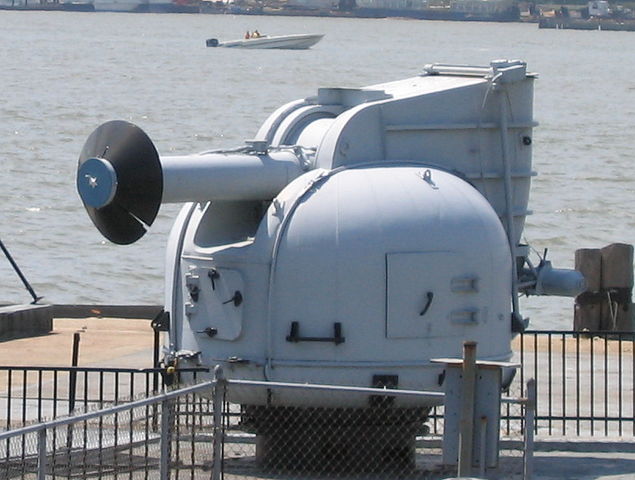
The main early cold war ASW rocket launcher, replacing the Hedgehog and “Mousetrap” systems.
The RUR-4 “Weapon Alpha” or “Weapon Able” when first programmed, was an naval ahead-throwing anti-submarine warfare rocket launcher, which development started in 1946, until 1949, installed on all escort warships from 1951 to 1969. It was a range, guided weapon to compare with the British “Limbo mortar” for example. It was carried by USS Norfolk and two were installed on the Mischer class, one superfiring above the 76mm DP mount and the other, same aft. This made a three-stage disposition reminiscent of the WW2 Atlanta class, but with varied weapons systems.
Specs:
- Mass: 525 pounds (238 kg)
- Length: 8 feet 6 inches (2.6 m)
- Diameter: 12.75 inches (324 mm)
- Warhead: High explosive (HE) 250 pounds (110 kg)
- Detonation mechanism: Depth charge by influence or time pistol
- Extra guidance: SQG-1 depth-finding sonar setting time fuse
- Propulsion: 5.25 in (133 mm) rocket, solid fuel
- Range: 800 yards (730 m) at 190 miles per hour (310 km/h)
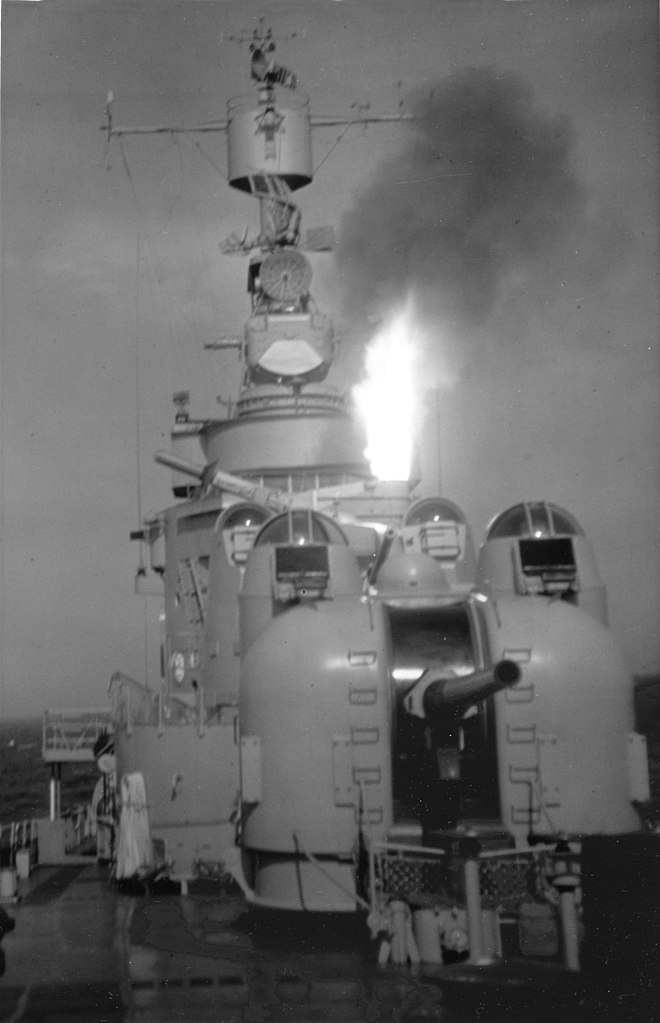
USS Wilkinson fires a RUR-4 Weapon Alpha off Newport, Rhode Island 1956
Depth charge rack
Plans shows a single rack aft, on the right poop side, for eight DCs of the standard type of the time, possibly the stock 1945 Mark 14 type (340 lbs./154 kg), 200 lbs. (91 kg) Torpex charge, sink Rate/Terminal Velocity of 23 fps (7.0 mps). A builder model shows two Mark 3 DC racks at the poop. Conways and others sources confirms a single one. It’s likely it was also removed after the 1960s refits and overhauls and considered anyway as a “backup”. There is no info about the quantity of depth charges reloads carried.
Onboard Electronics
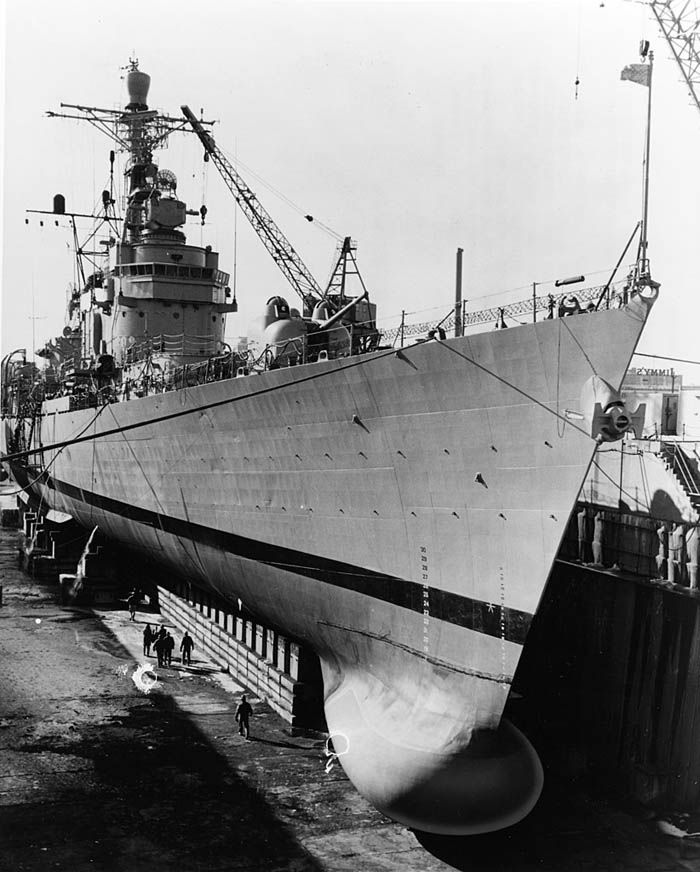
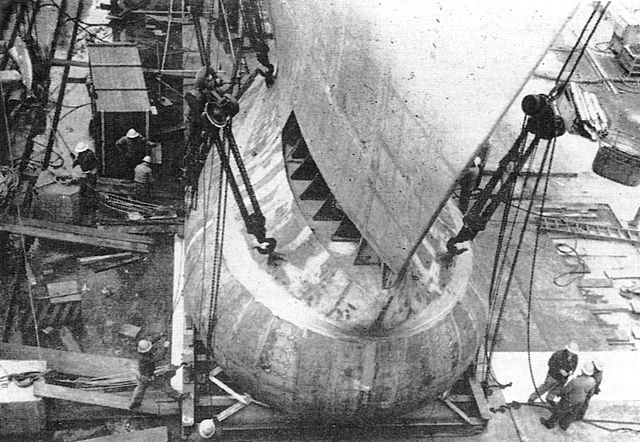
USS Willis A Lee’s hull sonar in drydock, Boston Navy Yard 1966
Radar SPS-6: Bendix/Wetsinghouse (1948) 2D L Band 500Kw 130 – 260 km (70 – 140 nmi)
Radar SPS-8: GE (1952) 2D S Band 650 kW 1000 Hz Bwt 3.5° Pwt 2 µs 111 km (60 nmi)
Sonar QHB: USN’s first ‘scanning’ WW2 sonar (Mk37 GFCS) Hull mounted, Active, Max Range: 3.7 km src
Sonar SQG-1: Coupled with the RUR-4 “Weapon Alpha”. 44V, 3 phases, 2 cycles, 45-55 Kcycles 10Kw Pwdt: 5-60 ms src
Sonar SQS-4: Sangamo Electric (1948?) 440V, 3 phases, 60 Cycles, 26 Kcycles, 4000 yds range, 600 full scale, 60Kw, transm. 7-100 ms Pwdt src
—Post DDG conversion——
Radar SPS-37
Radar SPS-48
Radar SPG-15 (DASH conversions)
Sonar SQS-23
⚙ Mitscher as built specifications |
|
| Displacement | 3,642 tons standard; 4,855 full load |
| Dimensions | 490 x 47.5 x 14.7 ft (150 x 14.5 x4.5 m) |
| Propulsion | 2 shaft geared steam turbines, 4 boilers: 80,000 shp (60,000 kW) |
| Speed | 30 knots (56 km/h; 35 mph) |
| Range | 4,500 nmi (8,300 km; 5,200 mi) at 20 kn (37 km/h; 23 mph) |
| Armament | 2×5-in, 4×3-in, 4×2 20 mm AA, 4×21-in TTs, 2x Weapon Alpha ASWRL, 1 DCR |
| Protection | Limited (see notes) |
| Crew | 28 officers, 345 ratings |
Modernization and Conversions
By the mid-1950s, their electronics were upgraded, with the retention of their QHB, SQG-1 sonars but the addition of the SQS-4 sonar. In 1957 all received tw twin 76mm/70 Mk 37 in replacement for their 76mm/50 as explained above.
By 1960 USS Mitscher, John S. McCain retained a single twin 76mm/70, but received the SPS-6 radar, SPS-29 radar, SQS-23 sonar and a DASH QH-50 helicopter deck and hangar.
Willis A. Lee and Wilkinson meanwhile received a partial FRAM modernization with a single twin 76mm/70 had their SPS-4, SPS-6 radars and SQS-4 sonar removed. They received also a DASH QH-50 helicopter with spot and hangar, and were added the SPS-10, SPS-29 radars and SQS-26 sonar. They also receiced a 324 Mk 108 Weapon Alfa ASWRL.
Mitscher in 1965-66 retained a single twin 76mm/70.
FRAM Conversion (Lee and Wilkinson)
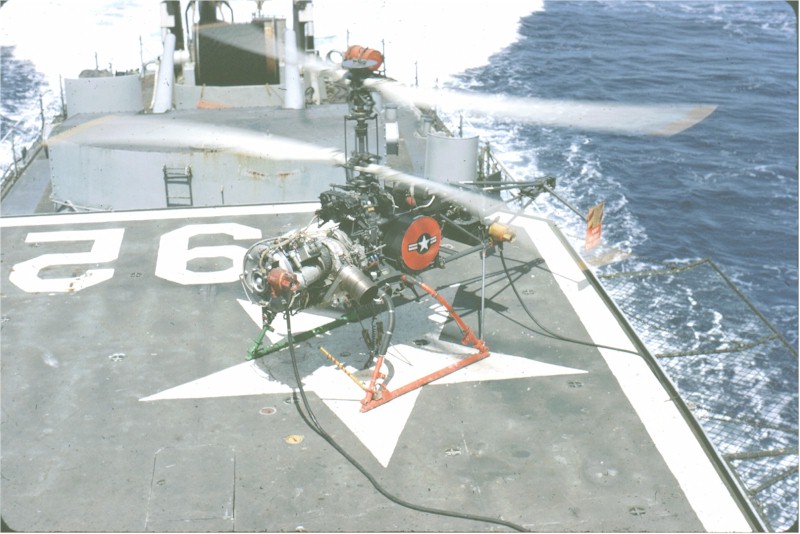
DASH: A platform was installed aft for a Gyrodyne QH-50 Drone Anti-Submarine Helicopter Mark II (1962) powered by Porsche YO-95-6 engines and able to send a single Mk 43 homing torpedo on target.
It consisted of an uprade in ASW capabilities, with “helicopter” hangar in place of the aft 3-in twin gun housing a Gyrodyne QH-50 DASH; plus topside antisubmarine torpedo armament, the standard Mk48 acoustic model. “Weapon Alfa” removed, bow-mounted sonar dome installed with new underwater sound-ranging standard. Willis A. Lee pioneered it. For USS Wilkinson it was less extensive. In 1960, for five-month (versus a year for Lee) her overhaul was limited to an enlarged Combat Information Center, addition of a long-range air search radar and DASH system, but no better hull sonar.
Conversion as fleet escort destroyers, missile (DLG)
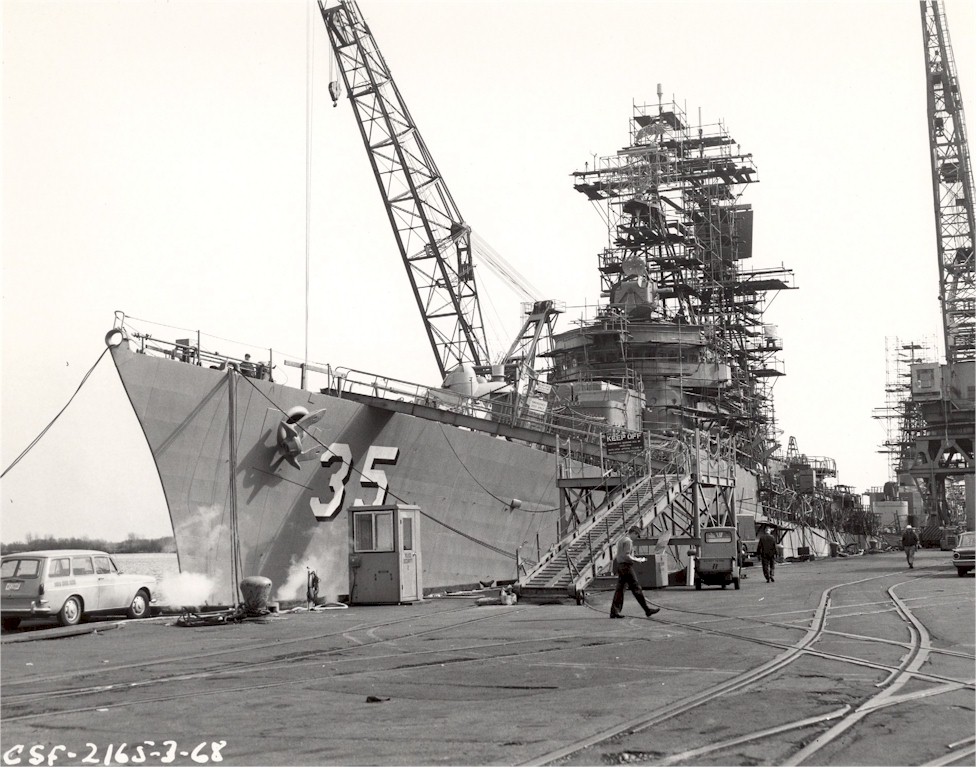
Reconstruction of USS Mitscher. This was a nearly three years endeavour, and costly for a fairly short career afterwards, moslty due to repeated engine problems, between the turbines and boilers. They should have stayed in service until 1988-89.
This guided missile destroyers, Leader (DLG) reconstruction was intended to keep at least two of these vessels relevant (Mitscher and Mc Cain), but still in part as testbeds. The two others being either modernized to FRAM or austere FRAM, USS Lee and Wilkinson were merely a cost-saving decision. Compared to Forrest Sherman and subdsequent destroyers, these vessels were very costly to maintain and operate.
This 1968-69 reconstruction consisted in:
-1 Tartar SAM (40 RIM-24) aft (in place of the Weapon alpha and 76mm/70)
-1×8 ASROC ASuR (16 RUR-5) forward (same).
-2x 127mm/54 Mk 42 retained fore and aft
-2×3 324mm Mk 32 TT new triple banks either deck side
-Radar SPS-37
-Radar SPS-48
-Radar SPS-10
-2x Mk 25 FCS radars
-2x SPG-51 FCS radars
-SQS-23 sonar (ASROC)
-WLR-1, WLR-3, ULQ-6 ECM suites for electronic warfare
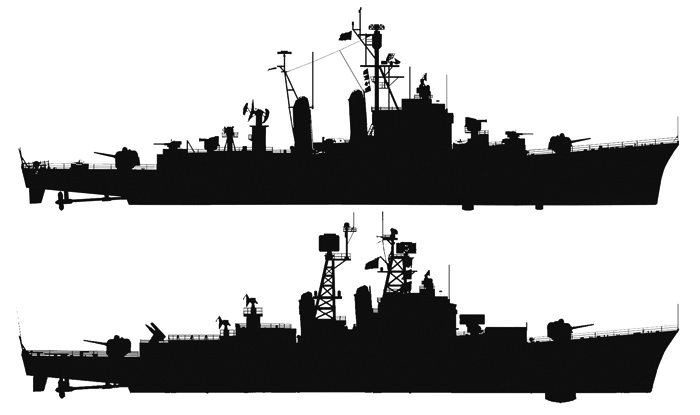
A comparison the unmodified USS Mistcher in 1958 and after 1968.
 USS Mitscher (DL-2)
USS Mitscher (DL-2)

Mitscher in 1953


Originally designated DD-927, she was laid down by the Bath Iron Works Corporation at Bath, Maine on 3 October 1949. Reclassified as a “destroyer leader” (DL-2) on 2 February 1951, she was launched on 26 January 1952, baptised by the widow of Admiral Mitscher, then commissioned on 15 May 1953 after initial trials.
Her first home port was Newport and she became as intended flagship for Commander Destroyer Flotilla 2. After her shakedown cruise off Cuba, she made her post-cruis fixes in Boston, and another shakedown cruise of confrmation to the same place and Guantanamo Bay until 31 August. From Newport she conducted exercises off the east coast, evaluating her capabilities until 3 January 1956. Next she departed for her first European tour, stopping in England, Germany, and France and back to Rhode Island (10 February). For 5 years these east coast operations and NATO exercises went on.
In 1955, USS Mitscher cruised the Caribbean with the Commander Destroyer Force US Atlantic Fleet as flagshuo and in 1958 was visited by President Eisenhower to assist to the America’s Cup Challenge Races off Newport. She made her first South America tour before another off Northern Europe plus NATO Exercises. By November 1960, she moved south to Naval Station Charleston as flagship, Commander Destroyer Flotilla Six (CF6). On 9 February 1961, she made her first Mediterranean 6-month tour of duty (TOD) with 6th Fleet, as flagship, Admiral Anderson, 6th fleet CDR.
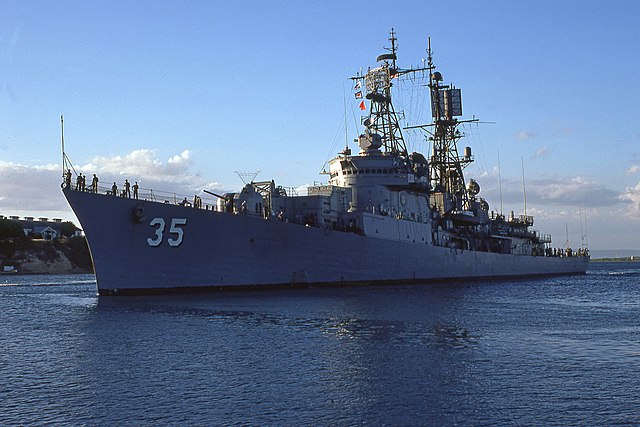
USS Mitscher off Cuba, Guantanamo Bay, January 1975
She returned to Newport, Rhode Island the next year and flagship, Commander Cruiser Destroyer Flotilla Two (CDF2). For 4 years, same homeport, she multiplied NATO exercises and those wit the 6th Fleet. In 1964 she made a 6-month Med TOD and by August she helped the evacuation of US nationals off Cyprus. She crossed the Suez Canal to patrol the Red Sea and Persian Gulf. In 1955 she made another 4 months Med TOD with the 6th Fleet.
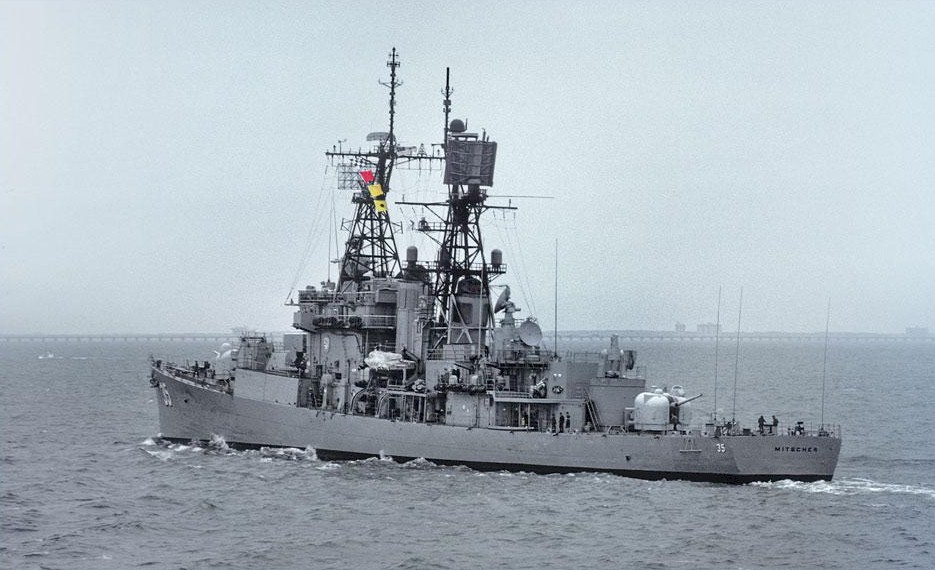
Mitscher in 1980
On 2 March 1966, she was taken in hands at Philadelphia Naval Shipyard for her missile destroyer conversion (18 March 1966-29 June 1968) with the new pennant DDG-35. In August 1970 she was in the Mediterranean tp host COMDESRON 1-4 and by July 1971 joined Destroyer Squadron 36 before another 1972 overhaul at Norfolk NYD. After a few years of uneventful service she was decommissioned and stricken on 1 June 1978, sold for BU in July 1980.
 USS John S. McCain (DL-3)
USS John S. McCain (DL-3)
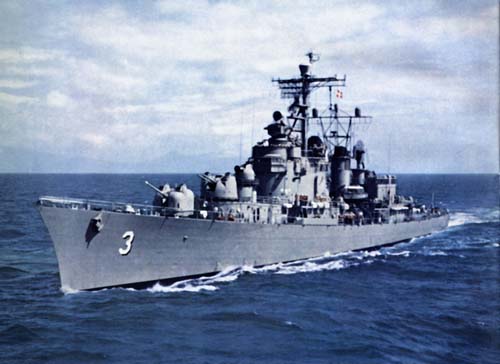
USS John Mc. Cain was commissioned on 12 October 1953 at Boston Naval Shipyard, and after sea trials and shakedown to the Caribbean Sea she arrived at her homeport Norfolk on 19 May 1955, starting tests with the Operational Development Force. She later transited through Panama, arriving in San Diego on 4 December 1956, followed by five months of Pacific and California coast exercizes.
She made her first asian deployment from 11 April 1957: Australia, Formosa (Taiwan), interposing between Nationalist and Communist Chinese and back to San Diego on 29 September 1957.
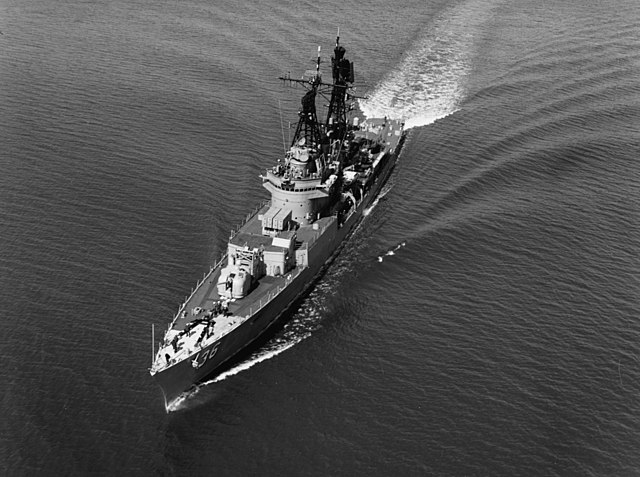
USS John S. McCain underway on 30 September 1969
By that time her new home port became Pearl Harbor and from 1958 she took part in fleet maneuvers, ASW drills for eight months. She returned in the South China Sea with the 7th Fleet as itwas feared an invasion of Quemoy and Matsu. She made a third deployment at the fall of 1959 (departure 8 September 1957), operating off Southeast Asia. She called Calcutta carrying medicine and food and to flood victims. In January 1960 she rescued the crew of Japanese freighter Shinwa Maru. Back in February in Hawaii, she started a long overhaul.
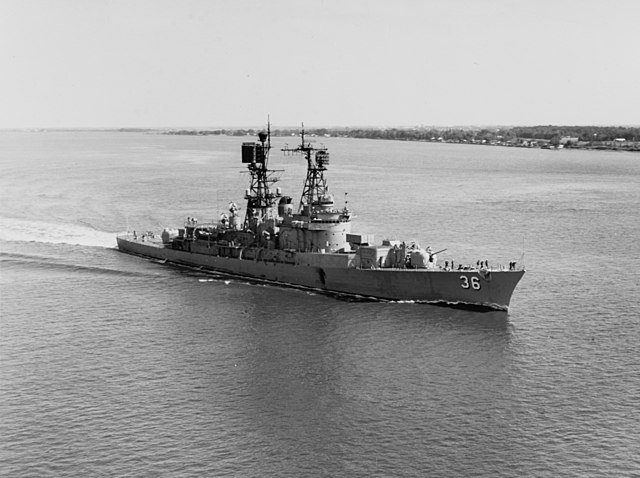
USS McCain in September 1969
Back at sea on 7 March 1961, 7th Fleet for six months, she operated off Laos and Vietnam. It was decided after USSR started, to launch a serie of Pacific tests. USS John S. McCain was posted to Johnston Island on 27 April 1962 as floating HQ. It was followed by regular runs between here and Hawaii unto late 1962, followed by patrols off the South China Sea, Gulf of Tonkin, in favor of South Vietnamese forces against the Viet Cong. Back in pearl on June 1963 she started ASW exercises from March 1964 with a hunter-killer group off Japan and in Philippine waters. She also operated wioth SEATO nations and the 7th Fleet. In 1965-66 she made another 6 month deployment and patrolled off South Vietnam.
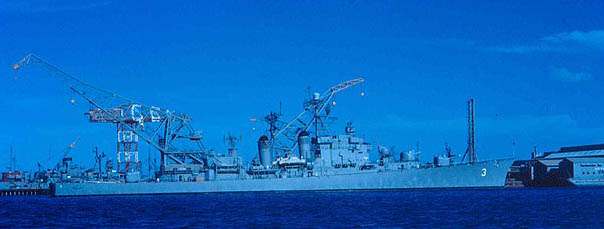
“Guard ship”, 1962
On 24 November 1965 she was at war, shelling Viet Cong positions. She stopped to Hong Kong and Japan for rest and replensihment before returning in Vietnamese waters in 1966, before leaving for the East Coast, Philadelphia Naval Shipyard, and her long and complex conversion to a guided missile destroyer in 1966-69. She only was recommissioned on 6 September as DDG-36. She went on for more service, plagued however to that point by engine problems, until she was eventually decommissioned and stricken on 29–30 April 1978, sold on 13 December 1979 and BU.
 USS Willis A. lee (DL-4)
USS Willis A. lee (DL-4)
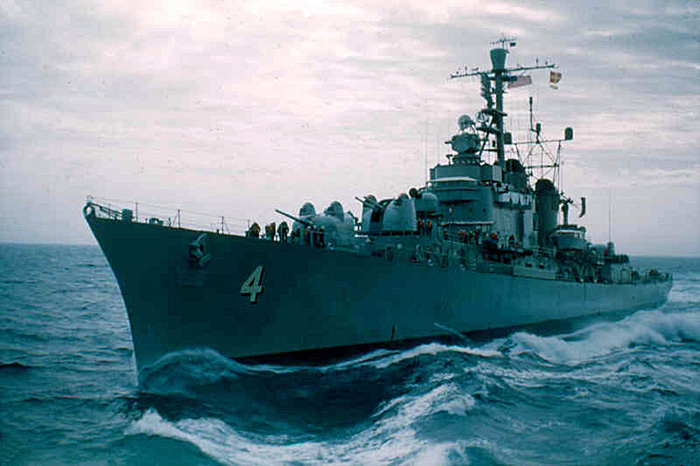
Commissioned on 5 October 1954, USS Willis A. Lee made her shakedown cruise off Cuba and was also based in Newport, Rhode Island at first. After some time in the Atlantic she made her first Mediterranean tour by July 1955 with the 6th Fleet and after being back home, operated off the eastern seaboard, taking part notably in important air defense exercises.
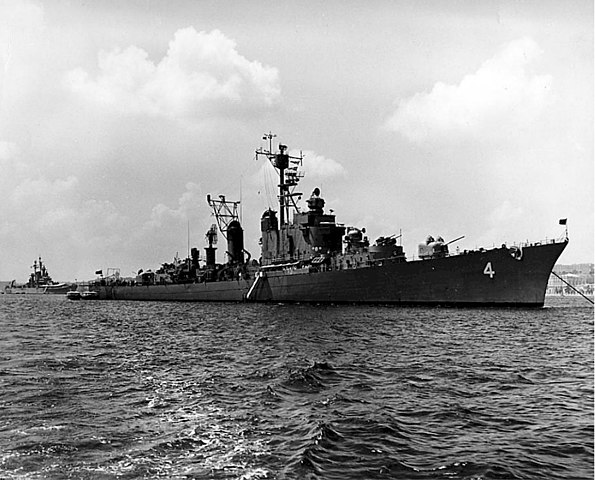
Willis A Lee off Istambul in 1955
By February 1956 USS Willis A. Lee became a frigate and represented the US in the Dominican Republic (American Day, Ciudad Trujillo). During a storm in very bad visibility, she hit rocks at Jamestown on 18 March and spent tome in repair at Boston NyD. In November 1956, she tool part in ASW while recuring the crew of a fishing vessel, Agda sinking off Montauk Point. By February 1957, she hosted King Ibn Saud of Saudi Arabia, for his first visit to NyC. She also took part in Washington, D.C. to the birthday of George Washington ceremonies and was the main ship filmed in “Windjammer” showcasing North Atlantic ASW exercises. She also took part in an International Naval Review off Hampton Roads followed by a combined NATO exercized in the North Atlantic

Off Newport, Rhode Island, June 1957
The following years she made two TOD in the Mediterranean (6th Fleet), and east coast exercizes of ASW and air defense. Operation “Inland Sea” was her responsibility as flagship, RADM E. B. Taylor, (TF 47) in 1959, including a cruise to the Great Lakes via the brand new St. Lawrence Seaway. She stopped in Chicago, Milwaukee, Detroit, Erie and Cleveland. In 1960 she was Commander, Destroyer Force, Atlantic Fleet, visiting many Atlantic Fleet ports down to San Juan, St. Thomas, Ciudad Trujillo, followed by the annual Carribean Operation “Springboard”. After a midshipmen cruise she visited Montreal and NYC, taking part in LANTFLEX and then international Operation “Sword Thrust” with 60 European and Canadian vessels. She crossed the Arctic Circle fir a second time. She stopped at Le Havre and was back to Newport, then was overhaul as part as FRAM in Boston NyD.
Emerging from the shipyard in September 1961, USS Willis A. Lee took part in the rescue of Texas Tower No. 2 (off Massachusetts), before she was badly hit by Hurricane “Esther”, leading the tower to be abandoned. Next she spent much time evaluating her brand new bow sonar from mid-Atlantic to the Caribbean. This arrived quite right in 1962 as to break the blockade, Soviet Premier escorted convoys with Soviet Diesels subs. She took part in the “quarantine line” for 10 days.
In February 1963 she was overhauled at the Boston NyD, also for improving her experimental sonar system and made tests in Haitian waters, stopping at Port-au-Prince. Later she took the head of the Destroyer Development Group 2 experimenting ASW defence until the rest of 1963, and another stop at Boston. Evaluation cruises in 1964-65 were punctuated by Exercise “Steel Pike” a massive amphibious exercise. She was flagship, RADM Mason Freeman (Cruiser-Destroyer Flotilla 2). Testing operations stopped by late 1965 for a lengthy overhaul directed at here unique powerplant, and modifications of her sonar system.
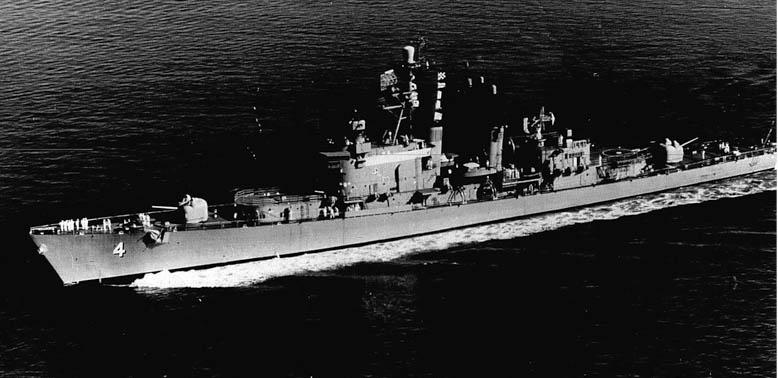
Lee underway in 1967-68
This routine of sonar development and testing from Newport and with fixes at Boston went on until 20 May 1967, followed by a Mediterranean tour from January 1968 and the Red Sea as flagship, COMMIDEASTFOR. Her propulsion problems proved faulty while off the coast of Brazil and she was repaired in Recife, Brazil, replaced by USS Luce (DLG-7) before heading for home. By January 1969 she was in Boston for a final overhaul. She was decommissioned in December 1969, sticken on 15 May 1972, sold for BU and towed to scrapyard on 5 June 1973.
 USS Wilkinson (DL-5)
USS Wilkinson (DL-5)
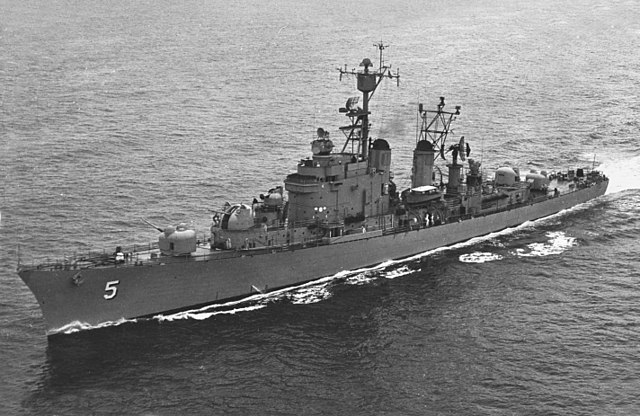
The last of these fleet escort destroyers and destroyer leaders was laid down at Bethlehem Steele on 1 February 1950, launched on 23 April 1952 and commissioned on 29 July 1954. After shakedown cruise off Cuba, post-shakedown fixes and availability, she was prepared in her first home port, Newport in Rhode Island for her first mission on 21 February 1955, porting RADM Arleigh Burke’s flag as Commander, Destroyer Force, Atlantic Fleet. Burke would become Chief of Naval Operations and had a massive destroyer class named after him. His tour included San Juan (Puerto Rico) St. Thomas (Virgin Islands) and Guantánamo Bay, Havana in Cuba then back Key West in Florida, now as flagship for Commander, Destroyer Flotilla two (DesFlot 2) in the reorganized Atlantic Fleet’s ASW forces, starting exercises.
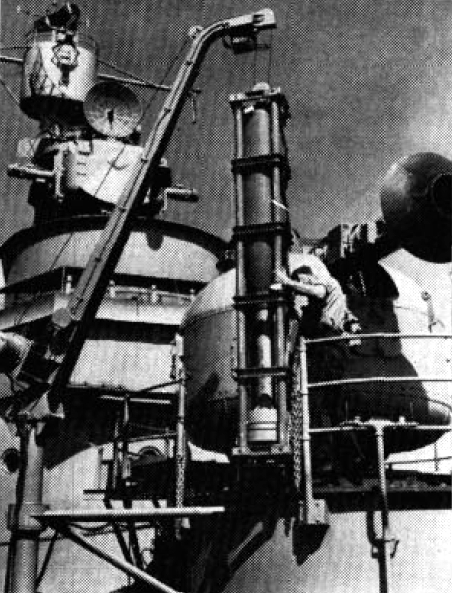
Weapon Alpha reloaded on Wilkinson in 1956
On 11 July 1955 she carried midshipmen for a training cruise to Edinburgh, Copenhagen, and back to Guantánamo Bay. She made another tour from 24 October 1955 for air defense exercises off Mexico, as flagship, DesFlot 6, stopping at New Orleans and Havana and back to Newport on 18 November, then a five-month overhaul with her 3 inch guns replaced by newer types and later new 3 in/70 battery while training off Guantánamo Bay. She called for Port-au-Prince, Charleston and Norfolk while taking part in large ASW maneuvers by June, earning the FY1956 Battle Efficiency “E.”
In July 1956, she departed fir San Diego via Panama and a first TOD in the Pacific Fleet, stopping in Havana, Balboa, Buena Ventura and vecoming flagship DesRon 17, forst of the Mitscher class in the Pacific Fleet. Until March 1957 she took part in many ASW, air defense, and amphibious exercises and soon after arrival on 14 September 1956 was part of a 70 fighting ships review off Long Beach. In April 1957 she went north to the Bering Sea and Aleutians (stopping at Kodiak and Dutch Harbor) and back to San Diego, touched at Esquimalt and Seattle, then San Francisco. RADM Chester Wood embarked for air defense/ASW exercises while later off Portland she was part of the annual Rose Festival activities.
New Home port became Long Beach in July 1957 and she was drydocked in 1958 for her troublesome power plant. She trained from September off Long Island and San Diego until December 1958. From January the next year she made her first WestPac cruise, arriving in Pearl Harbor and hitting Subic Bay, Buckner Bay, Kaohsiung (Taiwan) then Yokosuka and Kure and back to Long Beach with DesRon 19 Cdr aboard.
In 1959 after extra exercises off California she took part in the 1st Fleet review and started her second WestPac in October, joining the 7th Fleet for exercizes in the Taiwan Strait patrol. Back in March 1960, she had a 5 month overhaul, having her Combat Information Center enlarged and upgraded, new long-range air search radar, DASH installed. After six weeks of training off San Diego, month-long leave/upkeep she departed for her third WestPac on 3 January 1961 joining on the way DesDiv 191 in Pearl Harbor, Midway and Apra Harbor in Guam. March 1961 saw her in the South China Sea for the Laotian crisis, undeparting for home on 12 May.
She had upgrades in the Long Beach NyD by June (improved sonar), a refresher training (experiencing two accidental fires with victims) and was evaluated off Puget Sound, then exercized with submarines in the southern California operating area. She was to depart for her 4th WestPac on 17 June 1963, but went east, stopping en route at Acapulco and Salina Cruz before transiting Panama Canal to Newport and evaluations went on when she reached NyC, reclassified as “frigate” and continued testing her sonar system until May 1965. She also trained in the Caribbean and between Newport and New York, trained off Key West and Jacksonville. After an overhaul she trained again in Cuban waters (refresher) until 28 April 1966, helping the burning Norwegian pass. freighter Viking Princess.
After a stop at San Juan she was back in Newport on 2 May, then reached Boston for a large overhaul with a new sonar equipment mong other alterations and left on 15 August for sea trials and remained inactive at Newport apart a few steaming exercises (ISEs). She was in the Argentine waters for a review at Mar del Plata (4-8 February) and back on 5 March, reaching Bethlehem Steel Shipyard to receive a new data acquisition system for the sonar, participating later at the Veteran’s Day memorial services in Newport by 4 May. Next she was in Montreal, Canada for the “United States Week” in May, and the world’s fair Expo 67, being visited by President Lyndon B. Johnson, with her men serving as Presidential Honor Guard.
Back to Newport on 1 June and until late 1967, off Bahamas and Narragansett Bay she went one training mainly for ASW.
On 5 October she had a weak cleat snapping while her motor whaleboat was secured, striking a sailor, and returned quickly for his safety to Port Everglades. She was next at sea for more sonar tests with USS Grouper (AGSS-214), calling for Freeport (Grand Bahama) and back to Newport and upkeep at Norfolk NYD until December. In 1968 she went on with sonar technical evaluation and trained with USS Yosemite (AD-19) until a new overhaul at Boston NYD (13 September), and until June 1969. She visited NYC in July, trained in Narragansett Bay when was announced at the end of the year her decommissioned as part of budget cuts, entering Boston NYD for inactivation on 3 September 1969, then the Naval Inactive Ship Facility at Philadelphia, decommissioned on 19 December, but only stricken on 1 May 1974 sold on 13 June 1975.
Read More
Books
John Gardiner’s Conways all the world’s fighting ships 1947-1995
Fahey, James C. (1965). The Ships and Aircraft of the United States Fleet, 8hth Edition. Annapolis USNI
Friedman, Norman (1982). U.S. Destroyers: An Illustrated Design History. Annapolis USNI
Friedman, Norman (1984). U.S. Cruisers: An Illustrated Design History. Annapolis NIP.
Links
On seaforces.org
On Globalsecurity.org
On gyrodynehelicopters.com/
On alchetron.com
.wikipedia.org
On navypedia.org
On navsource.org/
Plans on northpoint
Model Kits
On scalemates: General – 1:350 Iron shipwright – 1:700 loose cannon
On motionmodels.com

 Latest Facebook Entry -
Latest Facebook Entry -  X(Tweeter) Naval Encyclopedia's deck archive
X(Tweeter) Naval Encyclopedia's deck archive Instagram (@navalencyc)
Instagram (@navalencyc)





 French Navy
French Navy Royal Navy
Royal Navy Russian Navy
Russian Navy Armada Espanola
Armada Espanola Austrian Navy
Austrian Navy K.u.K. Kriegsmarine
K.u.K. Kriegsmarine Dansk Marine
Dansk Marine Nautiko Hellenon
Nautiko Hellenon Koninklije Marine 1870
Koninklije Marine 1870 Marinha do Brasil
Marinha do Brasil Osmanlı Donanması
Osmanlı Donanması Marina Do Peru
Marina Do Peru Marinha do Portugal
Marinha do Portugal Regia Marina 1870
Regia Marina 1870 Nihhon Kaigun 1870
Nihhon Kaigun 1870 Preußische Marine 1870
Preußische Marine 1870 Russkiy Flot 1870
Russkiy Flot 1870 Svenska marinen
Svenska marinen Søværnet
Søværnet Union Navy
Union Navy Confederate Navy
Confederate Navy Armada de Argentina
Armada de Argentina Imperial Chinese Navy
Imperial Chinese Navy Marinha do Portugal
Marinha do Portugal Mexico
Mexico Kaiserliche Marine
Kaiserliche Marine 1898 US Navy
1898 US Navy Sovietskiy Flot
Sovietskiy Flot Royal Canadian Navy
Royal Canadian Navy Royal Australian Navy
Royal Australian Navy RNZN Fleet
RNZN Fleet Chinese Navy 1937
Chinese Navy 1937 Kriegsmarine
Kriegsmarine Chilean Navy
Chilean Navy Danish Navy
Danish Navy Finnish Navy
Finnish Navy Hellenic Navy
Hellenic Navy Polish Navy
Polish Navy Romanian Navy
Romanian Navy Turkish Navy
Turkish Navy Royal Yugoslav Navy
Royal Yugoslav Navy Royal Thai Navy
Royal Thai Navy Minor Navies
Minor Navies Albania
Albania Austria
Austria Belgium
Belgium Columbia
Columbia Costa Rica
Costa Rica Cuba
Cuba Czechoslovakia
Czechoslovakia Dominican Republic
Dominican Republic Haiti
Haiti Hungary
Hungary Honduras
Honduras Estonia
Estonia Iceland
Iceland Eire
Eire Equador
Equador Iran
Iran Iraq
Iraq Latvia
Latvia Liberia
Liberia Lithuania
Lithuania Mandchukuo
Mandchukuo Morocco
Morocco Nicaragua
Nicaragua Persia
Persia San Salvador
San Salvador Sarawak
Sarawak Uruguay
Uruguay Venezuela
Venezuela Zanzibar
Zanzibar Warsaw Pact Navies
Warsaw Pact Navies Bulgaria
Bulgaria Hungary
Hungary

 Bundesmarine
Bundesmarine Dutch Navy
Dutch Navy Hellenic Navy
Hellenic Navy Marina Militare
Marina Militare Yugoslav Navy
Yugoslav Navy Chinese Navy
Chinese Navy Indian Navy
Indian Navy Indonesian Navy
Indonesian Navy JMSDF
JMSDF North Korean Navy
North Korean Navy Pakistani Navy
Pakistani Navy Philippines Navy
Philippines Navy ROKN
ROKN Rep. of Singapore Navy
Rep. of Singapore Navy Taiwanese Navy
Taiwanese Navy IDF Navy
IDF Navy Saudi Navy
Saudi Navy Royal New Zealand Navy
Royal New Zealand Navy Egyptian Navy
Egyptian Navy South African Navy
South African Navy






























 Ukrainian Navy
Ukrainian Navy dbodesign
dbodesign